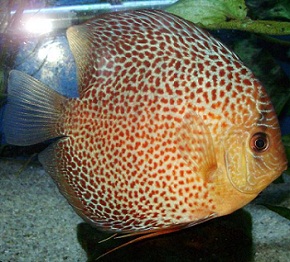Common Name:
Discus
Overview:
Considered the King of the freshwater aquarium, the discus is hard to find and picky in its water conditions. Not for the beginner as specialized tank and water parameters are needed to maintain them in good health. If your up to the task there are many color varieties available from specialized breeders.
Distribution:
Brazil, Colombia and Peru.
Coloration:
Today the different colors of the Discus can rival any marine fish. All of the new and exciting fish we have today came from pretty but not awe inspiring stock. In the wild this species has three subspecies which are distinguished by their coloration. Most of our beautiful variations have been breed from these original fish.
Care:
The dream of many aquarist is to keep the Discus. Not so few years ago the scarcity and high price limited their keeping to a few specialist. Thanks to these pioneers the Discus in its many colors are available to most hobbyist. Still expensive for a freshwater fish we want to make sure we can provide them with the proper environment.
Discus require special care and attention. The tank must be large enough to give plenty of open space and also lots of places to hide. These shy fish like to retreat among bogwood or vegetation when disturbed. Plants in a Discus tank should be robust and reach up to the surface of the water. Bog roots and driftwood as well as clay flowerpots can be added also. The substrate should be dark and the lighting subdued.
Water quality must be pristine. The water should be very soft and slightly acidic (2-3 degrees DH, pH about 6.5 ) older specimens can tolerate somewhat harder water. Temperature should be kept in the upper seventies to low eighties. The water should be well filtered with partial changes a must. Feeding the Discus can be a frustrating experience. Live food should be varied and given at every occasion possible. Tubifex, Daphnia and brine shrimp are great choices. Discus are very peaceful and should be kept in a species tank, other fish will keep them constantly on guard and they will never fully adapt. It is always best to keep a group of five or six and to disturb them as little as possible.
Breeding:
When well cared for and given a very varied diet these fish become sexually mature after about two to three years and will breed in the tank where they are being kept. They should never be transferred to a special breeding tank. A pair will separate themselves, usually during the spring, and chase the other fish as far as possible into a corner. Discus are typical open breeders with a quiet form of courtship and mating. The eggs are laid on rocks, more rarely on leaves, and they hatch in about 50 hours. Both parents tend the young, helping to "chew" them out of the egg membrane and transferring them to leaves. There they remain suspended by short filaments, are fanned by both the adults and finally start to swim after a further two to three days.
In contrast to nearly all other fish the young feed not only on very tiny animals but also, and mainly, on a skin secretion produced by the parents This is produced by large one celled skin glands, mainly in the region of the back; these glands increase in number during the period of brood protection. The adults, and particularly the female, thus fulfill the function of a lactating cow. The fry do not in fact swim free very much, but attach themselves to the adults and suck at their skin. The parents alternate their duties at this time. The young will concentrate on one parent until a flip of its tail shakes them off and sends them to the other partner. Gradually, however, the young start to taken an increasing amount of small food from the open water, so they must be supplied with brine shrimp nauplii and rotifers. The young have a typical elongated fish shape, but soon become more rounded. They grow rather rapidly and by three months they are the typical Discus shape. The juvenile coloration changes to the definitive pattern after eight to nine months. Finally, it should be noted that Discus frequently eat their own eggs.

